
Soil Conservation Practices
for Your Farm
What's the “PLUS”?
The “Plus” in 4R Plus involves in-field and edge-of-field agronomic and conservation practices that increase the resiliency and health of your soil, retain nutrients and moisture for the crop, reduce soil erosion and runoff losses and improve water quality. These practices help your soil remain productive, especially under variable weather conditions. The end result of healthier soil is higher productivity, better return on investment, less nutrient loss and cleaner water.
Introduction to Conservation Practices for Your Farm
Every farm is different, so the conservation practices that may help to keep soil and water in place on your farm may be different than those for a farmer in another part of Iowa. To that end, we have developed three videos to provide information about conservation practices on different landscapes. Choose the video that covers all types of Iowa farming landscapes and then watch the video that is most applicable to your farm – sloping land or flat and tile-drained land.
Conservation Methods Applicable to All Iowa Landscapes
Conservation Practices for Flat and Tile-Drained Landscapes
Conservation Practices for Sloping Landscapes
“Plus” Conservation Practices Included in the Iowa
Nutrient Reduction Strategy:
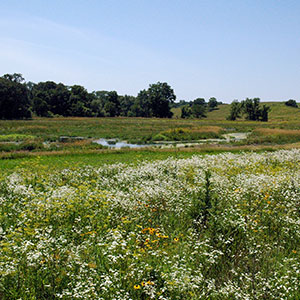
Conservation Cover
Establishing and maintaining permanent vegetative cover of either introduced or native grasses, legumes and forbs for nesting cover, winter cover, brood cover, pollinator habitat and food and habitat for wildlife.
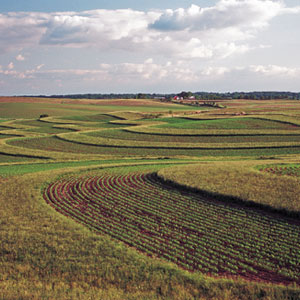
Contour Buffer Strip
Strips of grass or a mixture of grasses and legumes that run along the contour of a farmed field. They alternate down the slope of a field with wider cropped strips.
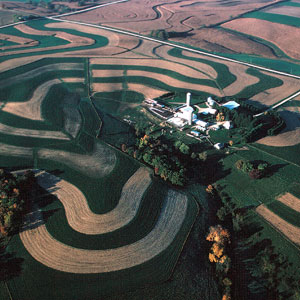
Contour Farming
Contouring means farming with row patterns nearly level around a hill – not up and down hill. The rows form small dams that slow water flow and increase infiltration to reduce erosion.

Cover Crop
Crops such as cereal rye, oats and winter wheat are planted to protect the ground from wind and water erosion and supply living roots to the soil during times when cash crops are not present.
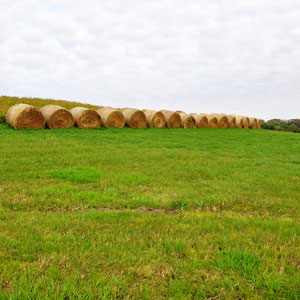
Crop Rotation
Growing different crops on the same piece of land year after year in a planned, recurring sequence. This may include alternating row cash crops such as corn and soybeans. It also may involve a rotation to a small grain or a grass legume and may include crops planted for cover or nutrient enhancements.
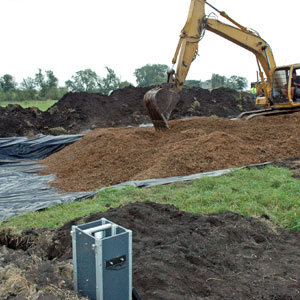
Denitrifying Bioreactor
An edge-of-field structure containing a carbon source, such as wood chips, installed to reduce the concentration of nitrate-nitrogen in subsurface agricultural drainage flow via enhanced denitrification by the carbon source (i.e. wood chips).
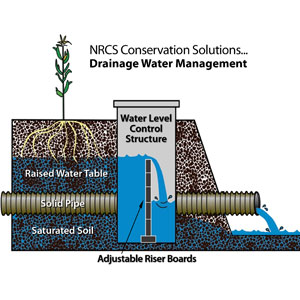
Drainage Water Management
Drainage water management is the process of managing water discharges from surface and/or subsurface agricultural drainage systems with water-control structures.

Field Border
A strip of perennial vegetation, primarily introduced or native grasses, established at the edge or around the perimeter of a field.

Filter Strip
A strip of dense herbaceous vegetation such as grass, trees or shrubs that filters runoff and removes contaminants before they reach water bodies or water sources, such as wells. Filter strips are most effective when used in combination with other agronomic or structural conservation practices.

Forage and Biomass Planting
Planting grass and legumes – suitable for pasture, hay, or biomass production – to reduce soil erosion and improve production.
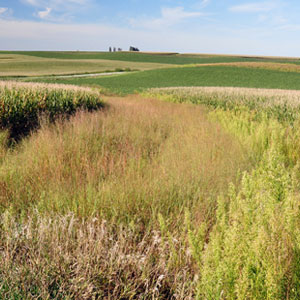
Grassed Waterway
Grassed waterways are shaped constructed channels that are seeded to grass or other suitable vegetation to direct water to a stable outlet at a nonerosive velocity. A structure is often installed at the base of the waterway to stabilize the waterway and prevent a new gully from forming.
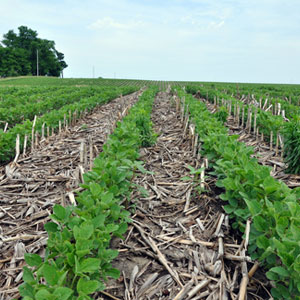
No-Till
Performing no full-width tillage from the time of harvest or termination of one cash crop to the time of the harvest or termination of the next cash crop in the rotation.
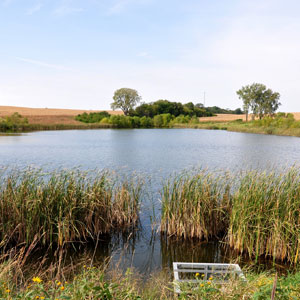
Pond
A pond is a pool of water formed by a dam or pit. There are two types of ponds – embankment ponds, which are water impoundments made by constructing an embankment, and excavated ponds, which are formed by excavating a pit or dugout.
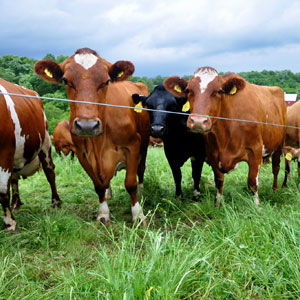
Prescribed Grazing
Managing the harvest of vegetation by livestock. This is often attained through a rotational grazing system where pastures are divided into four or more pastures with fencing. Livestock are moved from pasture to pasture on a prearranged schedule based on forage availability and livestock nutrition needs.

Saturated Buffer
A saturated buffer is a vegetated buffer in which the water table is artificially raised by diverting the water from a subsurface drainage system along the buffer to reduce nitrate loading to surface water via enhanced denitrification.
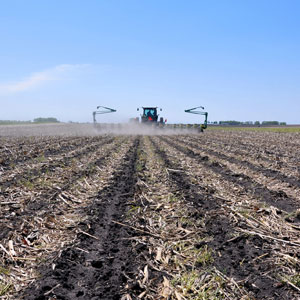
Strip-Till
A system in which residue-free strips of soil are tilled ahead of planting. The strips are approximately 6 inches wide or about one-third the row width and 4 to 8 inches deep. These strips are cleared of residue and tilled for warming and drying purposes either before or during the planting operation.
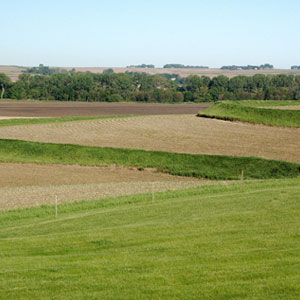
Terrace
An earthen embankment constructed across a field slope. They break long slopes into shorter ones – usually following the contour. There are two basic types of terraces – storage terraces and gradient terraces. Storage terraces collect water and store it until it can infiltrate into the ground or release through a stable outlet. Gradient terraces are designed as a channel to slow runoff water and carry it to a stable outlet.
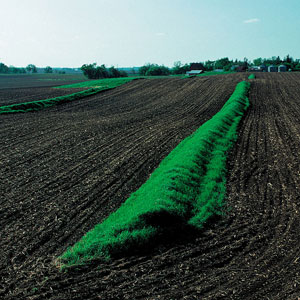
Water and Sediment Control Basin
An earth embankment or a combination ridge and channel constructed across the slope of minor watercourses to form a sediment trap and water detention basin with a stable outlet.
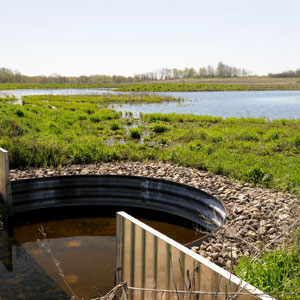
Wetland
A wetland is strategically placed to improve water quality through the removal of nutrients, specifically nitrates. A wetland may have standing water year-round or may hold surface water for only part of the year. Through NRCS assistance, wetlands can be created, enhanced or restored.
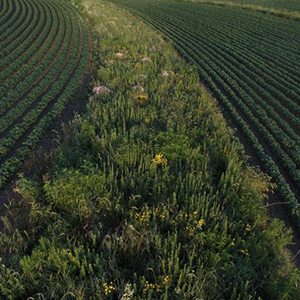
Prairie Strips
Prairie species slow water to provide erosion control, improve water quality and provide wildlife habitat. Prairie strips can be placed within or around the edge of a field, alongside or perpendicular to waterways or in terrace channels.
Learn more about in-field and edge-of-field conservation practices:
➢ Conservation Choices, Your Guide to 32 Conservation and Environmental Farming Practices
Natural Resources Conservation Service.
➢ CleanWaterIowa.org
Iowa Department of Agriculture and Land Stewardship.
Source of conservation practice definitions and photos: Iowa NRCS
Best Management Practices to Build Healthy Soils
- Reducing tillage to minimize soil disturbance and improve soil structure.
- Leave crop residue on the soil surface to protect it from the impact of rainfall.
- Grow cover crops to protect the soil and feed soil microorganisms between cropping seasons.
- Apply adequate fertilizer and manure using the 4R principles of right source, right rate, right time and right place.
- Use manure to enhance soil biology and soil health.
- Control field traffic to reduce compaction.
- Add a small grain or alfalfa to a corn-soybean rotation.
- Utilize contour buffer strips, field buffers and stream buffers.
- Enroll highly erodible areas into the Conservation Reserve Program.
- Use prescribed or rotational grazing.
Video resources for conservation practices
Soil Testing Makes Economic Sense
Precision Ag Specialist, Emily Doyle, says soil fertility testing is the foundation for a farm’s prescribed 4R nutrient stewardship program. Watch the video to find out why she encourages farmers to test soil.
No-till and Cover Crops Keep Soil Productive
Fayette County, Iowa, farmer Tim Recker says after years of tillage the organic matter in the soil was declining. He switched to no-till and added cover crops and benefits from higher productive soils.
The Many Benefits of Cover Crops
Fayette County, Iowa, farmer Tim Recker sees multiple benefits using cover crops. Watch the video to learn about the benefits he sees as well as some tips to get started.
Rethink Tillage
Fayette County, Iowa, farmer Tim Recker is experiencing multiple crop and soil health benefits since changing his tillage system. He says the less disruption to the soil, the better.
Wetlands Benefit Everyone
Wetlands are an edge-of-field practice that help to dramatically reduce the amount of nitrates going into surface waters downstream. Shawn Richmond, former director of environmental technology, Agribusiness Association of Iowa, explains how this practice is used on the landscape.
4R Plus Practices for All Iowa Landscapes
There are 4R Plus practices that can be implemented on virtually any farm regardless of topography. Learn about the agronomic, conservation and land management practices that can work in every region of the state.
4R Plus Practices on Sloping Iowa Landscapes
Learn about the practices that can be used on sloping landscapes that are not tile drained. These practices reduce soil erosion and therefore, particulate phosphorus losses from fields.
4R Plus Practices on Flat and Tile-Drained Iowa Landscapes
Learn about edge-of-field practices best suited for flatter and tile-drained landscapes that direct tile water into treatment areas to remove nitrates and sediment
